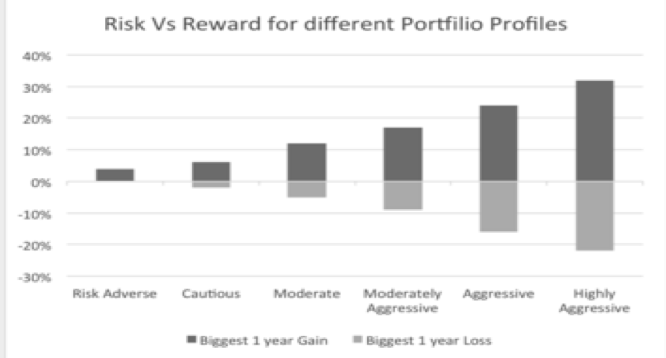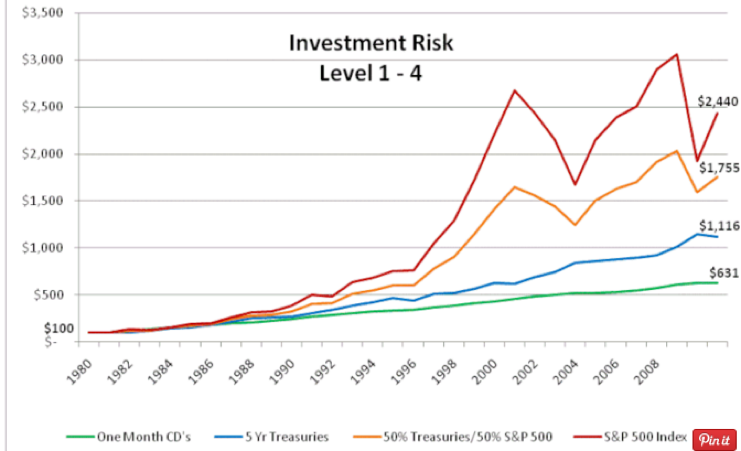What is risk?

Looking for a risk definition and want to know what risk means? Risk is when there’s a possibility that an investment’s real return will differ from its expected return. This includes the prospects of losing the total of the original investment, or at least a portion of it. There are various different versions of risk and the most common way of measuring it is to calculate the average or historical returns of an investment’s standard deviation. Contribution margin ratio, operating leverage effect ratio and financial leverage ratio are all additional ways to calculate risk.
Key takeaways
Risk is the possibility that an investment's actual return will differ from expected return, including potential loss of principal, and is most commonly measured by calculating standard deviation of historical returns.
The risk-return tradeoff principle demonstrates that higher risk investments offer greater potential returns, with aggressive portfolios yielding larger gains or losses while conservative investments like FDIC-insured bank CDs offer safer, lower returns.
Systematic risk (market risk) affects entire markets and cannot be eliminated through diversification, encompassing four major factors: currency risk, equity risk, commodity risk, and interest rate risk from market-wide events.
Unsystematic risk is company or industry-specific uncertainty that can be reduced through diversification, while other financial risks include liquidity risk, credit risk, foreign investment risk, and asset-backed risk.
Diversification and hedging, risk management strategies developed by Nobel Prize-winner Dr. Harry Markowitz, help balance systematic and unsystematic risk by combining various investments or strategically offsetting asset movements.
Where have you heard about risk?
Risk is a term that we encounter as soon as we begin to form our investment strategies. It is very unusual to make even a low cost, straightforward investment without weighing up the pros and cons, the cons being viewed as risks. A prominent idea in finance is the relevance of the risk-return tradeoff, which is the concept that the larger the risk an investor is willing to make, the larger the possibility for return.
The Graph Below highlights the risk vs. reward for different portfolio profiles and shows that highly aggressive portfolios are most likely to make large gains, but also large losses. Meanwhile, more risk averse portfolios are less likely to make losses, but also make smaller gains.

For instance, it's much safer to place a form of investment in the US government than a new business, as the business is far more likely to go bankrupt than the government of the United States. However, the potential for return with investment in a new business is much higher than that of the US government, making the risk-return trade-off more volatile, but potentially more lucrative.
In the US, there are certain riskless securities where the concept of the risk-return trade-off doesn’t apply as much, for example bank certificates of deposits (CDs). This is because bank deposits are insured by the FDIC (Federal Deposit Insurance Corporation), a department created with the sole purpose of preserving consumers’ faith in US banks. The US Three Month Treasury bill is also viewed as a no risk security, as it's assessed alongside securities that have much higher levels of volatility. As of 1 July 2016, the 91-day T bill, bought at a discount to par value, has a yield to maturity of 0.27%. These securities are relatively few and far between and are generally associated with the more conservative investor. The graph below illustrates the difference in return in low to high risk investments.

What you need to know about risk...
There are various types of risks and most are evaluated by working out the standard deviation of the historical returns or the standard returns of an investment. Risk is associated with financial transactions too, for example the default risk linked to company loans. There is an entire science devoted to managing market and financial risk that was developed by Dr Harry Markowitz, a Nobel prize-winner in Economics.
There are many different types of risks to consider when dealing with an investment or transaction. Some of which are detailed below:
Market risk
Market risk is the term used to describe the possibility that an investor may encounter losses due to the performance of the markets that they are a part of. Market risk is also referred to as systematic risk and can’t be eradicated by diversification. Recession, major political problems and societal turmoil are all factors of market risk. In the United States, it is compulsory for companies to detail how their performance, results and productivity levels might be linked to the performance of the financial markets. The point of this being that it exposes how a company may be vulnerable to financial risk.
There are four major market risk factors which are currency, equity, commodity and interest risk.
- Currency risk: which is the risk that foreign exchange rates or their implied volatility may change, leading to devaluation of an asset held in that currency
- Equity risk: which is the risk that the general price of stock (unrelated to any particular industry or business), or the implied volatility, will shift
- Commodity risk: which is the risk that commodities (steel, wheat, petrol), or their implied volatility, will change
- Interest rate risk: is the risk of a shift in interest rates or their implied volatility
Financial risk
Financial risk is the many different forms of risk related to financing, some of which are detailed below.
Asset backed risk
A risk that changes one or various assets that support an asset back security. This change will also change the security which is being supported. Term modification, interest rate and prepayment all factor in as risks.
Liquidity risk
This is when there's a risk that an asset or security can't be traded fast enough to stop a loss from occurring or to make the profit that's needed. There are two different forms of liquidity risk – asset liquidity and funding liquidity. Asset liquidity happens when it's not possible to sell an asset because of the lack of liquidity in the market. Funding liquidity happens when there's a risk that a liability can only be met at an inadequate price or can't be met when due.
Credit risk
This is also referred to as default risk and takes place when there's a risk that the borrower may not make payments as agreed (defaulting). An investor can be responsible for credit risk using leverage. Investors could also suffer from a smaller flow of cash, larger collection costs and lost principal and interest.
Foreign investment risk
This is the risk of extreme changes in the value of your assets because of various issues including, but not limited to, valuation, regulation, liquidity, smaller markets, shifts in accounting and economic issues.
With countless investments and transactions being made worldwide, there are obviously going to be many different types of risks (operational risk, reputational risk, model risk and legal risk to name a few). What you need to do first and foremost is be aware of what they are and then protect yourself against them to the best of your ability, ensuring that you’re aware of systematic and unsystematic risk.
Systematic and Unsystematic Risk
Systematic risk is the intrinsic uncertainty in the markets, or portions of a market. Also known as market risk, un-diversifiable risk and, most commonly, volatility, systematic risk highlights the day to day changes in the price of a stock. This type of risk measurement focuses on the actual behaviour of your investment and not the root of this behaviour. Movement in the market is how people can make money from stocks, and systematic risk is essential for returns.
Unsystematic risk is the doubt associated with the industry or company that you invest in. This type of risk, also referred to as specific risk, residual risk or diversifiable risk, can be lowered through diversification.
Diversification is the most popular way of moderating unsystematic risk. This strategised form of risk management incorporates an assortment of investments that are part of one portfolio. The aim is to minimise risk or volatility, which is why investments in a wide variety of assets are made. The idea is that a portfolio made up of various investments will, on average, produce greater returns and will present a lessened risk than any one lone investment within that particular portfolio.
Diversification was formalised, named and developed in the 1950s by the economist Harry Markowitz and the modern understanding of the term would not exist if it wasn't for his work. Financial diversification aims to balance systematic and unsystematic risk in a portfolio, so that the positive achievements of those investments neutralise the weak performance of the others.
Hedging is another popular form of risk management and involves strategically combining assets that are chosen to offset the movements of one another. For example, when investing in stock you can buy an option to sell that stock at a specific price in the future. That interacted portfolio of stock and option is now more unlikely to shift below a given value. As with the diversification method, there is an extra cost, as there’s a premium on buying options. There are various different financial risks that can be protected against by using hedging. These include interest rate, currency, commodity, credit and equity risk to name a few. Derivatives are also widely used to navigate many types of risks.
Find out more about risk...
Our glossary has lots more information on different forms of risk and the workings of the stock market, for example risk attitude. Alternatively, you could take a more in-depth look at the process of hedging. Kira Brecht of U.S News piece “3 Risks For The Stock Market Ahead” is a fascinating read and great for some current comparisons.